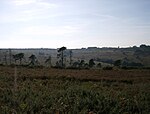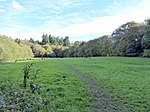Ashdown Forest is an ancient area of open heathland occupying the highest sandy ridge-top of the High Weald Area of Outstanding Natural Beauty. It is situated some 30 miles (48 km) south of London in the county of East Sussex, England. Rising to an elevation
of 732 feet (223 m) above sea level, its heights provide expansive vistas across the heavily wooded hills of the Weald to the chalk escarpments of the North Downs and South Downs on the horizon.
Ashdown Forest's origins lie as a medieval hunting forest created soon after the Norman conquest of England. By 1283 the forest was fenced in by a 23 miles (37 km) pale enclosing an area of some 20 square miles (52 km2; 13,000 acres; 5,200 ha). Thirty-four gates and hatches in the pale, still remembered in place names such as Chuck Hatch and Chelwood Gate, allowed local people to enter to graze their livestock, collect firewood, and cut heather and bracken for animal bedding. The forest continued to be used by the monarchy and nobility for hunting into Tudor times, including notably Henry VIII, who had a hunting lodge at Bolebroke Castle, Hartfield and who courted Anne Boleyn at nearby Hever Castle.
Ashdown Forest has a rich archaeological heritage. It contains much evidence of prehistoric human activity, with the earliest evidence of human occupation dating back to 50,000 years ago. There are important Bronze Age, Iron Age, and Romano-British remains. The forest was the centre of a nationally important iron industry on two occasions, during the Roman occupation of Britain and in the Tudor period when, in 1496, England's first blast furnace was built at Newbridge, near Coleman's Hatch, marking the beginning of Britain's modern iron and steel industry. In 1693, more than half the forest was taken into private hands, with the remainder set aside as common land. The latter today covers 9.5 square miles (25 km2; 6,100 acres; 2,500 ha) and is the largest area with open public access in South East England. The ecological importance of Ashdown Forest's heathlands is reflected by its designation as a Site of Special Scientific Interest, as a Special Protection Area for birds, and as a Special Area of Conservation for its heathland habitats. It is part of the European Natura 2000 network as it hosts some of Europe's most threatened species and habitats.Ashdown Forest is famous for serving as inspiration for the Hundred Acre Wood, the setting for the Winnie-the-Pooh stories written by A. A. Milne. Milne lived on the northern edge of the forest and took his son, Christopher Robin, walking there. The artist E. H. Shepard drew on the landscapes of Ashdown Forest as inspiration for many of the illustrations he provided for the Pooh books.












